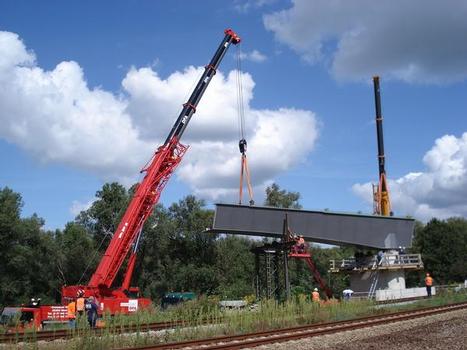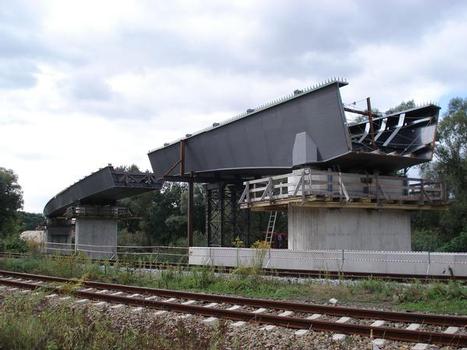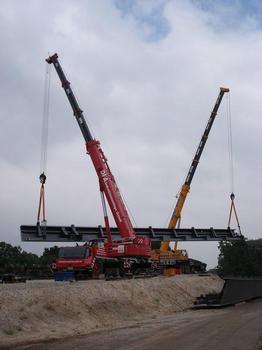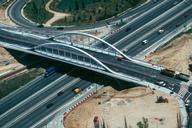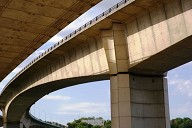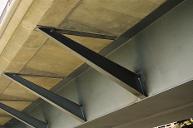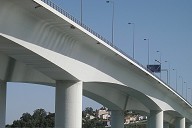Unusual bridge-building project
The B1 trunk road stretches right across Germany, from the River Oder via Potsdamer Platz in Berlin, all the way to Aachen. At the Polish border, congestion in the village of Küstrin-Kietz is being eased by a bypass for border traffic. This entails building a new 564.50 m composite steel bridge spanning the Berlin–Poland rail link, local roads and a stormwater canal for the Oder.
Media
Consulting engineers Holzapfel, Rüdt & Partner, based in Stuttgart, were appointed to carry out the structural engineering work. Manager Dr.-Ing. Jürgen M. Sättele and his team headed by engineer Hanjo Krimmer provided the accurate structural calculations required to begin construction work on this EUR 10.5 million bridge-building project on schedule. This was no easy task in view of the difficult initial conditions. The bridge, which is curved on plan and elevation and has 11 spans with a maximum span of 73.00 m, crosses a flood protection area that may not be affected. The steel girder system therefore had to be built from both sides. The individual sections made of U-shaped, open steel trough cross-sections are assembled at the abutments and then pushed in the longitudinal direction of the bridge. Only in the middle part of the bridge could the steel sections be lifted into position.
The bridge is located on a bend with a radius of 800 m and the imposing structure has an overall width of 12.20 m. The cross-section is haunched in the area of the railway line and the construction depths vary between 2.40 and 3.40 m. Due to the "soft” cross-section of the trough, a superelevation of the web plates of up to 400 mm is planned. As the two webs are of different depths because of the transverse slope, there were differences in deformation and therefore superelevation differences between the webs of up to 30 mm. "We calculated each web separately,” explains Krimmer.
Challenging concreting work
The concreting of the bridge deck is also a complex procedure involving no less than 33 concreting stages. To make optimum use of the cross-section, concreting is being carried out according to the step-back technique and, due to the initial conditions at the eastern end of the bridge, partly in a continuous process. The cycle time is a week. In order to be able to take up the horizontal component from the concreting loads with the diagonal webs, horizontal tension ties have to be installed. The tension ties also have to be disassembled again to enable the 65 tonne formwork carriage to move over the structure. "The load during concreting is immense,” reports Krimmer.
Maximum loads
To minimize the calculation work, the engineers chose a one-bar model – calibrated with a three-bar model for the static calculation. Deformations were calculated with the three-bar calculation model due to the web depths. The assembly of the 1600 tonne steel girder system was mapped in simplified form with four construction conditions. The engineers simulated the production of the road deck accordingly with 19 concreting states. In total, Sättele and Krimmer and their team performed the calculations on both models with 28 primary and secondary construction conditions. The concreting conditions were extremely critical for the open cross-section of the trough of structural steel grade S355 because it is torsionally "soft” at this time. Another challenge for the structural engineers was the structural bearings (some of which were twisted), the curvature of the system axis on plan and elevation and the relatively heavy formwork carriage. As a consequence of the high load of the steel girder system, flange plate thicknesses of up to 110 mm and web plates with closely spaced stiffeners had to be installed. An equally difficult task was the exact determination of the superelevation curves in the webs, as the web depths on the left and right are different.
Software system for complex calculation methods
For calculation and bond dimensioning in the final state, the engineers at Holzapfel, Rüdt & Partner worked with RIB bridge construction software PONTI® verbund. Besides loads of building construction in progress and permanent loads, 850 traffic load cases were used in the one-bar model in 25 structural conditions. Secondary effects also had to be taken into account. Bond dimensioning was designed according to the DIN report for all usual verifications in the limit states of loadbearing capacity, fatigue, suitability for use and bonding agent excluding buckling. "Without the high-performance software of RIB it would not be possible to perform such complex calculations with so many system and cross-section changes, and over 850 load cases with the required accuracy within this time,” Sättele sums up. "We've been using RIB software systems for many years for structural designs and measurements and they are particularly useful for complex construction projects.”
Structure Types
- About this
data sheet - Product-ID
6278 - Published on:
16/05/2013 - Last updated on:
21/11/2016



